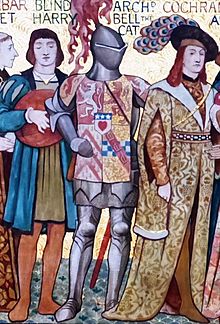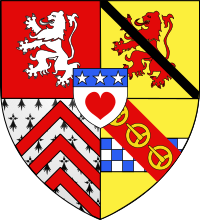Archibald Douglas, 5th Earl of Angus facts for kids
Quick facts for kids
Archibald Douglas
|
|
|---|---|
| Earl of Angus | |

Archibald 'Bell-the-Cat' depicted as a notable figure in Scottish history by the Victorian artist William Hole
|
|
| Predecessor | George Douglas, 4th Earl of Angus |
| Successor | Archibald Douglas, 6th Earl of Angus |
| Born | c. 1449 |
| Died | October 1513 (aged 63–64) Whithorn, Kingdom of Scotland |
| Buried | Whithorn Priory |
| Father | George Douglas, 4th Earl of Angus |
| Mother | Isabella Sibbald |
Archibald Douglas, 5th Earl of Angus (born around 1449, died October 1513) was a powerful Scottish nobleman. He was a peer, a politician, and a very important person in Scotland. People gave him the nickname Archibald 'Bell-the-Cat' because of his part in a rebellion in 1482 against King James III of Scotland. He became one of the most influential nobles in Scotland. This was partly because of his important role in the Scottish Marches, which were border lands. He also took part in many rebellions during the reigns of King James III and King James IV of Scotland.
Contents
Who Was Archibald Douglas?
Archibald Douglas was the oldest son of George Douglas, 4th Earl of Angus. His family was part of the "Red Douglas" line of the famous Clan Douglas. Archibald was born at Tantallon Castle in East Lothian, Scotland, around the year 1449. His mother was Isabella Sibbald. Her father was the Master of the Household for King James II of Scotland. This meant her father was a very important official in the king's home.
Growing Up in Tough Times
Archibald grew up during the 1450s, which was a difficult time in Scotland. His father, the 4th Earl of Angus, supported King James II. This put him against many members of his own clan, especially the "Black Douglas" line, who were rebelling against the king.
In 1460, Archibald's father was at the siege of Roxburgh Castle. The king died by accident during this siege. It is said that Archibald's father placed the crown on the head of the new child king. He supposedly declared, "There! Now that I have set it upon your Grace's head, let me see who will be so bold as to move it." Archibald became the 5th Earl of Angus about two years later, around 1462 or 1463, when he was about fourteen years old.
Archibald and King James III
In 1481, Scotland was preparing for war with England. King James III made Angus the Warden of the East March. This was an important job protecting the border. However, the very next year, Angus joined a secret group of Scottish nobles. On July 22, 1482, they surprised the king at Lauder.
How He Got His Nickname
At this time, English forces had just invaded Scotland. The nobles who secretly disliked the king were part of the army James had gathered to fight the invasion. A writer named David Hume of Godscroft later wrote about this event. He said that Archibald earned his nickname here by offering to "bell the cat." This meant he would be the one to start the action against the king's favorite advisor, Thomas (or Robert) Cochrane. This was the first step before arresting the king.
Angus is said to have started the attack by grabbing a gold chain from Cochrane's neck. Then, he ordered Cochrane and other royal favorites to be hanged from Lauder Bridge. This bridge is now located on the grounds of Thirlestane Castle. The saying "to bell the cat" comes from an old fable called "The Mice in Council." It means taking on a dangerous task that will help everyone.
Rebellions and Forgiveness
After this event, Angus joined the king's younger brother, Alexander Stewart, Duke of Albany. Albany was part of the English invasion. He had made a deal with King Edward IV of England. Albany agreed that the English king would be the ruler over Scotland. In return, Albany would rule Scotland instead of his brother. While King James was held captive in Edinburgh, Albany did try to rule for a short time as "Alexander IV."
However, by March 1483, both Albany and Angus returned to support King James. Even though they had made a deal with England, King James forgave them.
Later in the same decade, another rebellion against the king began. This time, more Scottish nobles supported it. Even the king's oldest son, James, Duke of Rothesay, joined them. Angus once again sided against the king. In 1488, he marched against James III at the Battle of Sauchieburn. After the battle, the defeated king died mysteriously.
Archibald Under King James IV
After the Battle of Sauchieburn, Angus became one of the guardians for the young King James IV. But he soon lost some of his power to other noble families, the Homes and the Hepburns. The important job of Warden of the Marches went to Alexander Home.
Secret Deals and Lost Castles
Even though Angus seemed to be on good terms with King James IV, he secretly made a deal with King Henry VII of England around 1489 or 1491. In this deal, Angus promised to follow England's instructions when dealing with King James. He also agreed to hand over Hermitage Castle. This castle was very important because it controlled a pass into Scotland through Liddesdale. In return, Angus would receive lands in England.
In October 1491, Angus made his castle of Tantallon stronger against King James. But he had to give in. He exchanged his lands in Liddesdale and Hermitage Castle for the lordship of Bothwell.
Back in Favor
In 1493, Angus was back in the king's good graces. He received many grants of land. He became the Chancellor, which was a very high office, and he kept this job until 1498. In June 1497, he helped start talks for the surrender of Perkin Warbeck. In 1501, he was in trouble again and was held at Dumbarton Castle.
Archibald's Final Days
Angus's two oldest sons were killed at the terrible Battle of Flodden in early September 1513. Archibald himself was not at the battle. As the Scottish nation was dealing with this huge defeat, Angus was appointed as one of the advisors to the Queen Regent, Margaret Tudor. Shortly after, by the end of October, Archibald Douglas also died. His grandson, Archibald Douglas, 6th Earl of Angus, became the next Earl of Angus.
Archibald's Family
Archibald Douglas was married twice:
- On March 4, 1468, he married Elizabeth (who died in 1498). She was the daughter of Robert Boyd, 1st Lord Boyd.
- In the summer of 1500, he married Katherine Stirling. She was the daughter of Sir William Stirling of Keir.
He also had a mistress named Janet, who was the daughter of John Kennedy, 2nd Lord Kennedy.
Children from His First Marriage
| Name | Birth | Death | Notes |
|---|---|---|---|
| George Douglas, Master of Angus | 1469 | September 9, 1513 | Married Lady Elizabeth Drummond in March 1488. They had children. He was killed at the Battle of Flodden. |
| Lady Mariot Douglas | 1470 | Married Cuthbert Cunningham, 3rd Earl of Glencairn. They had children. | |
| Sir William Douglas | 1471 | September 9, 1513 | Married Lady Elizabeth Auchinleck. They had children. He was killed at the Battle of Flodden. |
| Gavin Douglas, Bishop of Dunkeld | c. 1472 | ||
| Lady Elizabeth Douglas | 1474 | ||
| Sir Archibald Douglas of Kilspindie | c. 1475 | 1522 | King James V gave him the nickname Greysteil. |
| Lady Janet Douglas | 1476 |


